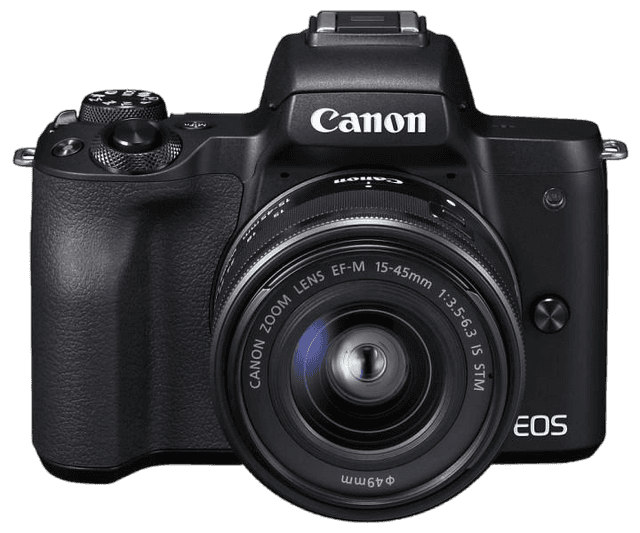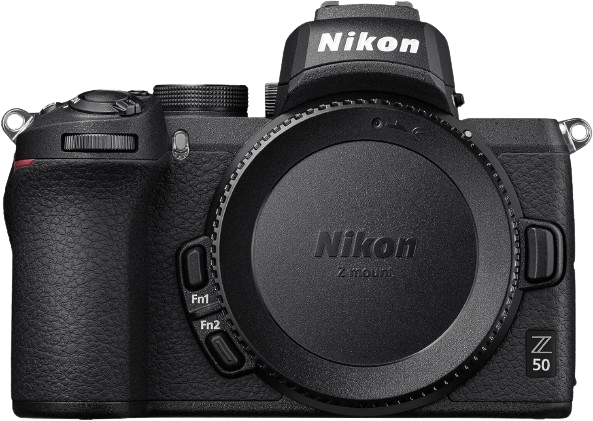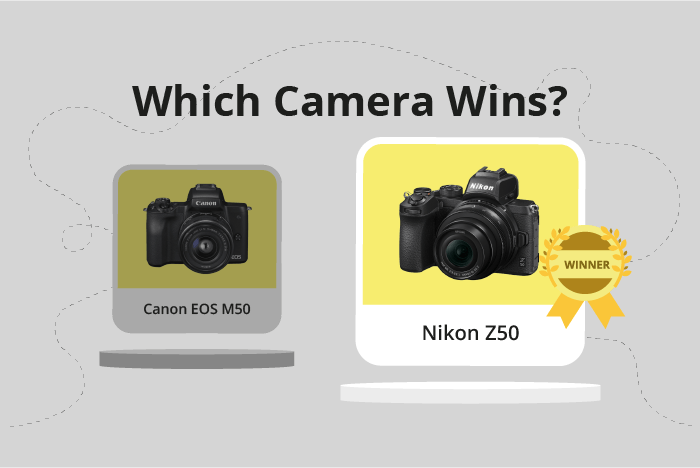Canon EOS M50 vs Nikon Z50 Comparison
Canon EOS M50

Nikon Z50

The Nikon Z50 outperforms the Canon EOS M50 with a score of 73/100 compared to 59/100. Both cameras are mirrorless and were released in 2018 and 2019, respectively. They share similar dimensions, with the Z50 being slightly larger and heavier.
The Nikon Z50’s higher score highlights its superior performance. Its advantages include a more recent release date and a higher launch price, indicating better features and technology.
On the other hand, the Canon EOS M50 is lighter and more compact, making it easier to carry around. However, its lower score suggests it may lack some of the advanced features found in the Z50.
Considering the points mentioned, the Nikon Z50 is the better camera due to its higher score, while the Canon EOS M50 offers a more portable option for those prioritizing size and weight.
Canon EOS M50 vs Nikon Z50 Overview and Optics
The Nikon Z50 outperforms the Canon EOS M50 in optics with a score of 72/100, compared to the Canon EOS M50’s 59/100. Both cameras share some common specifications, such as having a CMOS sensor, APS-C sensor size, and no image stabilization. However, there are key differences that set the two cameras apart.
The Nikon Z50’s superiority in optics is due to its higher DXOMARK sensor score of 97, which is significantly higher than the Canon EOS M50’s score of 58. This higher score translates to better overall image quality and low-light performance. Moreover, the Nikon Z50 has a faster shooting speed at 11 frames per second, compared to the Canon EOS M50’s 10 frames per second. The Nikon Z50 also features a more advanced processor, the Expeed 6, which contributes to faster image processing and improved image quality.
On the other hand, the Canon EOS M50 has a slightly higher megapixel count at 24, compared to the Nikon Z50’s 21. This allows the Canon EOS M50 to capture more detail in images. However, this advantage may not be significant enough to outweigh the benefits of the Nikon Z50’s superior sensor and processor.
Both cameras have their own proprietary lens mounts: the Canon EOS M50 uses the Canon EF-M mount, while the Nikon Z50 utilizes the Nikon Z mount. This means that each camera has access to a range of lenses designed specifically for their respective systems, allowing users to choose the best lens for their needs.
Considering the differences in optics performance, the Nikon Z50 is the better choice for photographers who prioritize image quality, low-light performance, and faster shooting speeds. Meanwhile, the Canon EOS M50 may be more suitable for those who value a slightly higher megapixel count and the Canon lens ecosystem.
Canon EOS M50 vs Nikon Z50 Video Performance
When comparing the video capabilities of the Canon EOS M50 and the Nikon Z50, both cameras tie with a score of 91 out of 100. This indicates that they have similar performance in terms of video recording.
Both cameras share key specifications, such as a maximum video resolution of 4K, dimensions of 3840 x 2160, and a top video frame rate of 120fps. Additionally, both cameras include built-in time-lapse functionality. These shared features make both the Canon EOS M50 and Nikon Z50 strong contenders for anyone looking to capture high-quality video.
In terms of advantages, the Canon EOS M50 offers the same video capabilities as the Nikon Z50, making it a suitable choice for videographers who prefer the Canon brand or are already invested in the Canon ecosystem. The Canon EOS M50 is a reliable camera that will deliver excellent video performance.
On the other hand, the Nikon Z50 also excels in video recording and shares the same specifications as the Canon EOS M50. This makes the Nikon Z50 a solid choice for those who prefer the Nikon brand or are already part of the Nikon system. The Nikon Z50 will provide outstanding video quality for users.
Both the Canon EOS M50 and the Nikon Z50 are excellent choices for capturing high-quality video, with their shared specifications and performance. The decision ultimately comes down to personal preference and brand loyalty, as both cameras offer similar video capabilities and will meet the needs of most videographers.
Canon EOS M50 vs Nikon Z50 Features and Benefits
The Nikon Z50 outperforms the Canon EOS M50 with a feature score of 86/100, while the Canon EOS M50 scores 70/100. Both cameras share several specifications, including a touchscreen, flip screen, WiFi, and Bluetooth connectivity. Neither camera has GPS.
The Nikon Z50 boasts a larger screen size at 3.2 inches, compared to the Canon EOS M50’s 3-inch screen. This difference allows for easier framing and better viewing of images on the Nikon Z50. Both cameras have the same screen resolution of 1,040,000 dots, providing clear and sharp image previews.
The Canon EOS M50, despite having a lower feature score, still offers a solid set of features. Its similarities with the Nikon Z50 in terms of screen resolution, touchscreen capabilities, and connectivity options make it a viable choice for photographers who value those aspects. However, it falls short in comparison to the Nikon Z50’s larger screen size.
When comparing the Canon EOS M50 and Nikon Z50, the Nikon Z50 stands out as the better camera due to its larger screen size and higher feature score. The Canon EOS M50, while not as feature-rich, remains a competent option for those who prioritize the shared specifications between the two cameras. Ultimately, the choice between these two cameras will depend on individual preferences and priorities.
Canon EOS M50 vs Nikon Z50 Storage and Battery
The Nikon Z50 outperforms the Canon EOS M50 in storage and battery, scoring 35 points compared to the Canon’s 13 points. Both cameras share similarities in storage, having one memory card slot and accepting SD, SDHC, and SDXC (UHS-I compatible) memory cards.
The Nikon Z50’s battery life surpasses the Canon EOS M50, with 320 shots versus 235 shots. The Nikon Z50 uses an EN-EL25 battery type and offers USB charging, making it more convenient for extended use. The Canon EOS M50, on the other hand, uses an LP-E12 battery type and lacks USB charging.
Although the Canon EOS M50 falls short in battery life and charging options, it still offers adequate storage options for photography enthusiasts. However, the Nikon Z50 is the superior choice for those seeking longer battery life and the convenience of USB charging.
Alternatives to the Canon EOS M50 and Nikon Z50
Are you still undecided about which camera is right for you? Have a look at these popular comparisons that feature the Canon EOS M50 or the Nikon Z50:

